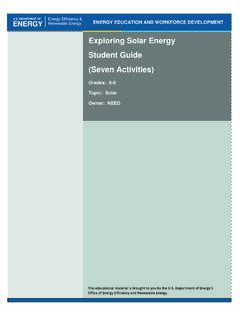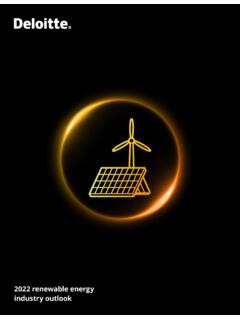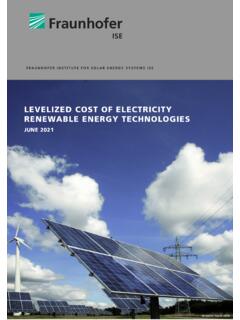Transcription of TAMIL NADU ELECTRICITY REGULATORY COMMISSION
1 Page 1 of 24 TAMIL NADU ELECTRICITY REGULATORY COMMISSION Consultative Paper on Generic Tariff order for Grid Interactive solar Energy generation System (GISS) (Comments invited by 01-09-2021) Page 2 of 24 Contents Sl no Description Page No Introduction 3 Technology 6 Legal provisions 7 Tariff Determination Process 11 Tariff Pricing and methodology 11 Tariff determination and compounds 12 Tariff rate 14 Net work charges 16 Applicability 17 Energy metering 18 Energy billing and accounting process 18 Standards and technical requirements 20 Grid connected application process 22 Operative control period 22 Annexure for LCOE calculation, network charges.
2 Form 1 and 2 23 Page 3 of 24 TAMIL NADU ELECTRICITY REGULATORY COMMISSION Consultative Paper on Generic Tariff order to Grid - interactive solar Energy generation system (GISS) Introduction The importance of grid connected solar energy generation system The TAMIL Nadu solar Energy Policy 2019 includes a consumer category solar energy target of 3,600 MW by 2023. As of 31st March 2021, only % of this target has been achieved. The TAMIL Nadu solar Energy Policy 2019 introduced two metering mechanisms for rooftop / ground mounted solar energy systems; net feed-in and gross feed-in, whereby the consumers could opt between the two metering mechanisms.
3 The COMMISSION had issued Tariff Order No. 3 of 2019 (Order on rooftop solar Generation) dated 25-03-2019. The tariff was determined as 75% of: i) pooled cost of power purchase for the respective financial year, or ii) the last feed-in tariff determined by the COMMISSION , or iii) the tariff discovered in latest bidding, whichever is less. For the financial year 2021-2022, this works out to be INR per kWh. Clause of the TAMIL Nadu solar Energy Policy states that the COMMISSION may introduce time-of-the-day (TOD) solar energy feed-in tariffs to encourage solar energy producers and solar energy storage operators to feed energy into the grid when energy demand is high.
4 With the declining cost of battery energy storage systems it is expected that prosumers will install consumer category solar energy system coupled with battery storage. These battery energy storage systems at the prosumer level (behind-the-meter) can provide essential gird services such as peak shaving, peak shifting and voltage support. Need for the consultative paper As of 31 March 2021, there is an installed capacity for rooftop solar energy of Page 4 of 24 325 MW to achieve the target set for 2023 another 3,275 MW will need to be added. ELECTRICITY (Rights of Consumers) Amendment Rules 2021 of GoI has furthered avenue for Nett metering, gross metering and net billing and contemplates TOD meter in line with TAMIL Nadu solar Policy as follows: The arrangements for net-metering, gross-metering, net-billing or net feed-in shall be in accordance with the regulations made by the State COMMISSION , from time to time.
5 Provided that where the regulations does not provide for net-metering, net-billing or net feed-in, the COMMISSION may allow net metering to the Prosumer for loads up to five hundred Kilowatt or up to the sanctioned load, whichever is lower and net-billing or net feed-in for other loads: Provided further that in the case of Prosumers availing net-billing or net feed-in, the Commissions may introduce time-of-the-day tariffs whereby Prosumers are incentivised to install energy storage for utilization of stored solar energy by them or feeding into the grid during peak hours thus helping the grid by participating in demand response of the Discoms.
6 Provided also that in case of net-metering or net-billing or net feed-in, the distribution licensee may install a solar energy meter to measure the gross solar energy generated from the Grid Interactive rooftop solar Photovoltaic system for the purpose of renewable energy purchase obligation credit, if any: Provided also that the COMMISSION may permit gross-metering for Prosumers who would like to sell all the generated solar energy to the distribution licensee instead of availing the net-metering, net-billing or net feed-in facility and the COMMISSION shall decided for this purpose the generic tariff for gross-metering as per tariff Regulations.
7 Thus a regulation needs to be enacted on reviewing the existing orders and norms and revising the same in accordance with the Consumer Rules. Also a generic tariff order on charges for net-metering, gross-metering, net-billing needs to be determined as contemplated in the consumer rules besides creating a substantial consumer awareness and information campaigns for the diverse set of consumers to achieve the objective of the solar policy. Page 5 of 24 As on 31st March 2021, TAMIL Nadu has a total installed power generation capacity of 33,695 MW (CEA, Executive Summary on Power Sector, March 2021).
8 The rooftop solar energy capacity installed in TAMIL Nadu as of 31st March 2021 represents the total installed power capacity and approximately the total energy consumption in the State. Month and Year rooftop solar capacity (MW) % of 2023 target Capacity addition required to meet the 2023 target (MW) March 2019 3,457 March 2021 3,275 Energy fed into the grid from rooftop solar systems and behind the meter energy storage systems does not require transmission and significantly reduces distribution losses since most of the generated energy is consumed at, or near to the point of generation.
9 This is expected to reduce the Licensee s average cost of supply. Additional benefits include: (a) voltage improvements; (b) reduction of transmission capacity charges; (c) Reduction of stress on lines and equipments; (d) generation-consumption matching (during grid outage both generation and consumption stop while in utility category systems generation stops with consumption carrying on elsewhere) (e) deferral of infrastructure up gradation. In order to accelerate the deployment of consumer category solar energy systems and to meet the State s target of 3,600 MW by 2023 a new grid connected solar energy tariff order that applies to all categories of metering mechanisms is proposed.
10 Additionally, the introduction of a ToD (time-of-the-day) feed-in tariff premium aims at promoting the uptake of grid-interactive prosumer energy storage systems. With the proposed revision of norms of gross metering, net metering and net feed-in mechanism the tariff applicable to the exported energy has been delinked from consumer tariffs. Page 6 of 24 Consumers may benefit from the self-consumption of solar energy, depending on the consumer retail tariff, the quantity of solar energy self-consumption and the times of the day of self-consumption.












